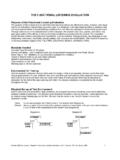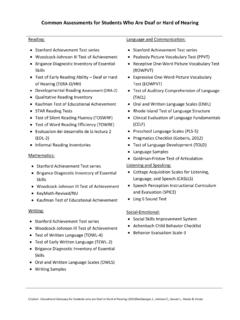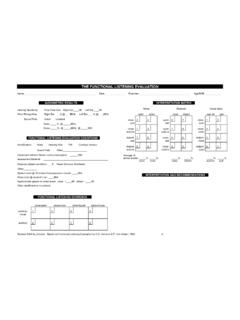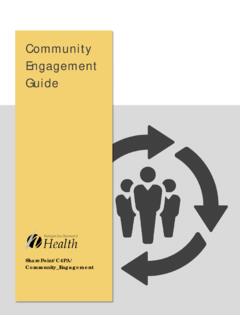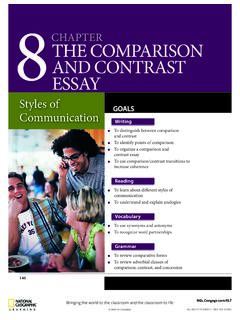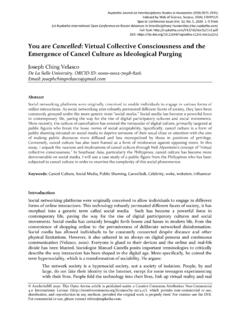Transcription of Deaf Culture & Community - Hands & Voices
1 What is Deaf Culture ?The American Deaf Community values American Sign Language as the core of a culturally Deaf identity. Through ASL, members are given a unique medium for personal expression, a spatial and visual language that does not require the use of sound and emphasizes Hands , faces, bodies and eyes. Members of this Community share a common history, values, mor-als and experiences. Deaf individuals come from diverse backgrounds and influences, and as a result that variation is reflected in the Community . Different types of sign systems are used to varying degrees, and the Deaf Community welcomes this Culture focuses on the stimulation of the eyes and the enhanced vi-sual perceptiveness of Deaf individuals. This has resulted in a great history of rich ASL literature and storytelling.
2 The oral tradition of storytelling has allowed members of the Deaf Community to pass down the histories of great Deaf men and women, providing for Deaf children access to role models that enable them to feel rooted in history, while also giving them mentors with common American Deaf Community is different from many thriving cultural groups around the world because it is not commonly recognized as dis-tinct and discrete. Most people are born within an existing cultural group gaining direct access to their family and Community cultural traditions, norms and values that are passed down from parent to child. Most deaf children, on the other hand, are born to hearing parents. For most Deaf children transmission of the Culture of the family or that of the deaf com-munity does not automatically occur.
3 Deaf children typically gain access to the Deaf Community through education in Deaf programs with other Deaf Culture & CommunitytmDeaf Culture & Community2 Communication Considerations A-ZTMdeaf children and adults. It is in these visual-spatial environments that a Deaf child becomes accultur-ated through language immersion as well as social interactions with others who share the same language and a similar world view that is experienced primarily through visual rather than auditory experiences. In programs designed with deaf children in mind, Deaf children are not only surrounded by a sizable number of Deaf students, which provides them with a socially accessible environment, but are also ex-posed to educational programming through which the student gains access to the Deaf Community , the history and the values of Deaf Culture .
4 Deaf organizations, at the local, state and national levels have been around for over a century. These groups provide a chance for members to socialize and often provide a system of support. For instance, The National Association of the Deaf does a great deal of work advocating for the civil rights of Deaf members and empowering individuals to become active within their own local communities. Deaf or-ganizations cater to every aspect of an individual s life from the athletic members who participate in the Deaf Olympics, to those seeking religious access in Deaf churches and through church interpreters. Deaf organizations provide a network for camaraderie and socialization, and many members remain loyal for their entire Deaf people talk about the sense of belonging they feel upon their first experience in this type of environment.
5 There is a feeling of home, and Community that comes from interaction with other Deaf people. The degree of hearing or fluency in sign language are not the only factors that define identifica-tion with the Deaf Community . Deaf people describe a sense of connection and a shared understanding of what it means to be a deaf person that is felt almost immediately upon meeting another person who is deaf. Scholars have attempted to describe the shared worldview experienced by most deaf people. Ben Bahan, in 1989, published an essay on the Seeing Person. The Seeing person requires a re-placement of focus, rather than on the deaf-ness of an individual, but on the shared qualities of deaf people as a cultural group. This view of being deaf emphasizes the visual nature of the Deaf individual and is celebrated.
6 The source of connection between Deaf individuals becomes a study of the eyes, not the ears. Markku Jokinen (2001), on the other hand, describes the Community based on their access to sign language. For Jokinen, the Community is identified through the use of Sign Language. According to this model, Sign Language Persons represent those individuals that are fluent sign language users from birth or a very young age. Jokinen s analysis provides a celebration of visual language skills, which again highlights the use of the eyes, the body and movement. Both Bahan and Jokinen provide a look at the Deaf Community that is based on Deaf values and perspectives. Deaf people don t focus on the inability to hear. Instead, classifying Deaf people as Seeing People and Sign Language Persons upholds positive traits that are valued and cherished.
7 What every parent and professional should know:A key point for consideration is communication opportunities. Deaf children of Deaf parents have access to both ASL and English. Deaf households are primarily bilingual and members of the Deaf Community highly value literacy. Historically, the Deaf Community and educators have engaged in an Deaf Culture & Community3 Communication Considerations A-ZTMimpassioned debate over the method of instruction and often English and ASL are presented as mutu-ally exclusive terms. Often parents feel pressured to choose one language option. Deaf cultural perspec-tive holds that communication access multiplies when several opportunities are available. Rather than believing that education should be presented in strictly English or strictly sign language, instructors can capitalize on the many avenues of communication.
8 A bilingual environment may be unique to the needs of the child, a profoundly deaf child can be bilingual in ASL and written English and a child with some auditory access may also be bilingual in spoken and written English and ASL. Language access is not described in terms of the use of one language, independently of any other. Instead, families should seek out communication opportunities in ASL and English and other ways of communicating that engage , educate and benefit their child. It is important to provide a Deaf child with access to visual technolog y. These tools, such as video phones with access to video relay services (VRS), cell phones or pagers with data plans for emailing and texting, light flashers connected to doorbells and phones, and closed captioning on the television, create an environment that is compatible with a Deaf worldview, and making them a permanent facet of a Deaf child s life provides him or her full access to the environment.
9 Cochlear implants (CI) have been on the forefront of Deaf cultural discussions for two decades. While implantation can be seen as a hot-button issue, it is important to make several distinctions. First, CIs are a product of a medical philosophical model that views deafness as an impairment to be cured. The child is measured in terms of hearing loss and reasonably expected gains and a great deal of physical and mental work is done to repair the deafened child. While this is seen to be in direct opposition to a Deaf cultural model, members of Deaf Culture recognize and embrace the diversity of the Deaf Community . Children with CIs are not permanently cured, and CIs, regardless of their ability to improve access to information through hearing do not change a deaf person into a hearing person.
10 ASL and Deaf Culture can and should continue to play an important role in the life of any child born deaf including those using cochlear implant technolog y - as an opportunity for cultural enrichment and of Deaf children will want to familiarize themselves with the Individuals with Disabilities Edu-cation Act, the Americans with Disabilities Act and other educational laws which impact the lives of Deaf children. These laws provide government support in creating an accessible education and accessible environments. Parents can use these resources and empower their families to advocate for greater oppor-tunities for their Deaf child. What issues are at the forefront ?The creation of a home environment that is linguistically accessible to a deaf child is and has been at the forefront of this field for decades.
